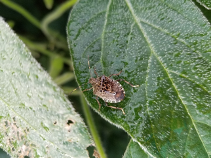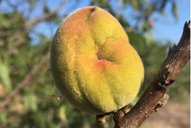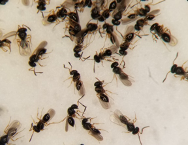By: Alison Grant, ISC Community Outreach Summer Student
Brown marmorated stink bug (Halyomorpha halys), or BMSB, is an invasive agricultural pest that is native to Taiwan, Japan, Korea and China. It was first recorded in 2001, in the United States in Pennsylvania. Nearly a decade later it was detected in Canada in Hamilton, Ontario in 2010. Today, this invasive insect is established in four provinces in Canada (Ontario, Quebec, British Columbia and Alberta) and 46 states in the U.S.

Why does it matter? BMSB causes serious damage to over 35 fruiting crops (such as grapes, apples, peaches, corn and soy). Although, BMSB is not limited to just agricultural crops, it has been observed to feed on over 170 host species in North America such as buckthorn species, honeysuckle species, dogwood species, and maple species. BMSB threatens Ontario’s $145 million tender fruit and grape industry including peaches, pears, plums, and nectarines (OMAFRA, 2019), and the $138 million apple industry (OMAFRA, 2019). Ontario’s prominent wine and grape industry might be jeopardized with the spread and persistence of the BMSB, with a total economic impact of $3.3 billion (Frank, Rimerman & Co. LLP, 2013) including impacts on jobs, taxes, and tourism. These potential impacts provide a glimpse into a wide range of potential economic threats that BMSB may impose in areas where it is established.
When feeding, BMSB uses its piercing proboscis (sucking mouthpart) to inject tissue-destroying enzymes into the fruit in order to extract the juices, therefore causing damage to the tissue and skin of the fruit, making it unmarketable. BMSB is a nuisance for homeowners by overwintering indoors, secreting odors and residue that makes a mess on surfaces. In Ontario, BMSB has primarily been a nuisance pest for homeowners, but farmers are now seeing an increase in BMSB injuries on their crops in areas where it’s been established.

During the spring, adult BMSB emerge from their overwintering locations as early as April. Feeding begins immediately as females require 2 weeks of feeding to reach sexual maturity. In a season, females can lay up to 400 eggs for a period of several weeks to several months. The eggs are laid on the underside of the leaf in masses of approximately 28 eggs. BMSB has 5 different nymphal (immature) stages that very in size and appearance. Each nymphal stage lasts about 1 week, depending on temperature. Nymphs and adults feed on a variety of host species, which is why BMSB causes high crop damage. During the fall, BMSB feed extensively before moving to their overwintering locations.
Control measures for BMSB in Canada are limited. There are some commercially registered products for controlling or supressing BMSB, but it is often required to be applied in high concentrations, which could cause environmental issues. In some studies, BMSB has shown resistance against insecticides. Research on BMSB is ongoing to determine the extent of its potential impacts and the efficacy of monitoring, management and control options that are available. For example, biocontrol research is being conducted on a non-native parasitoid wasp, Trissolcus japonicas, to determine if it is BMSB-specific because you would not want it to impact other non-host species.

Everyone can play a role in monitoring this and other invasive species by reporting your sightings! Monitoring is an important step in slowing the spread and movement of invasive species. By reporting your sightings, we are able to determine population size and distribution of BMSB in North America.
If you would like to learn more about Brown Marmorated Stink Bug read our species profile.
References:
Fruit and veg production stats:
(OMAFRA) Ontario Ministry of Agriculture, Food and Rural Affairs. 2019c. Horticultural crops. Fruits. Area, production, and farm value by crop. (http://www.omafra.gov.on.ca/english/stats/hort/index.html)
(OMAFRA) Ontario Ministry of Agriculture, Food and Rural Affairs. 2019d. Horticultural crops. Vegetables. Area, production, and farm value by crop. (http://www.omafra.gov.on.ca/english/stats/hort/index.html)
